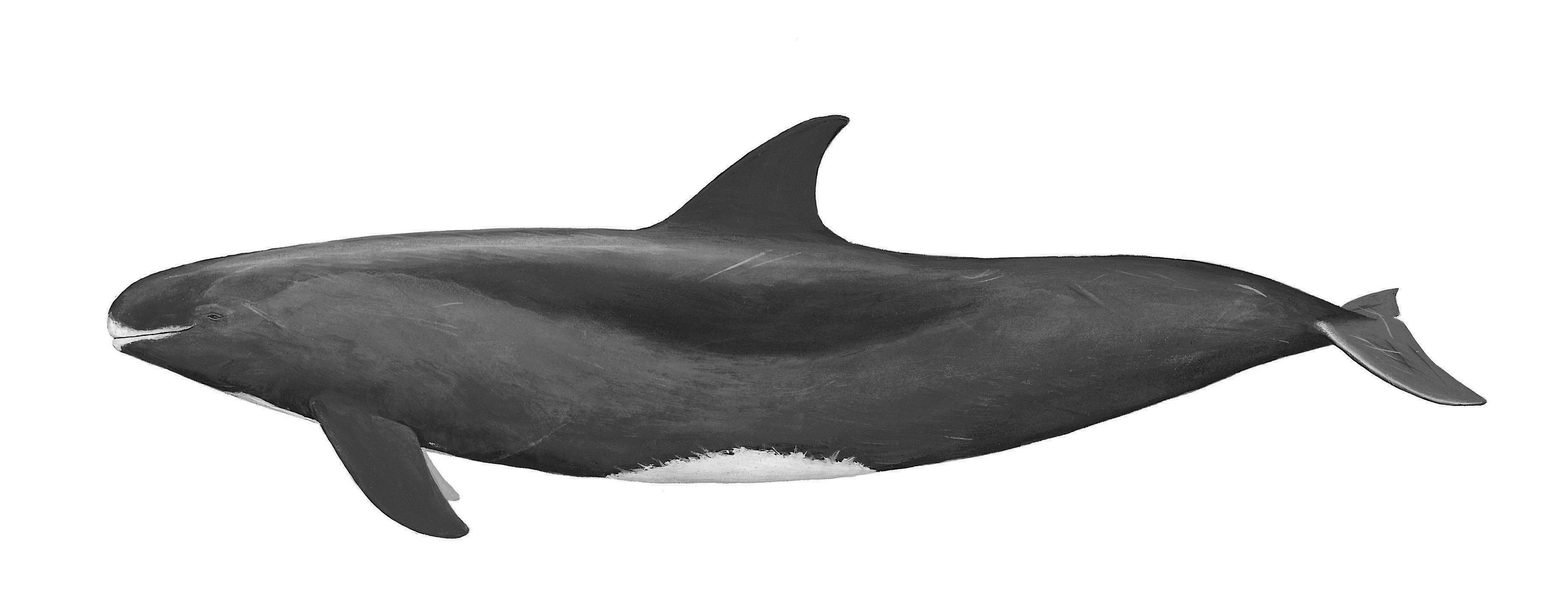PYGMY KILLER WHALE
Feresa attenuata Gray 1874
Order Cetacea : Family Delphinidae
DESCRIPTION. A small, blunt-nosed, toothed cetacean similar to the false killer whale (Pseudorca) but dorsal fin larger and teeth considerably smaller; body color black with white patches around mouth and on chest and abdomen; dorsal fin about 220 mm high, 375 mm long at base, and located near midpoint of back; teeth about 8 mm in diameter at alveolus, <30 mm in length, and numbering 9–13 in each tooth row; 68–71 vertebrae (50 in Pseudorca). Total length about 2.5 m.

DISTRIBUTION. Deep tropical, subtropical, and warm temperate waters of the world. Known in Texas on the basis of three strandings and several sightings. One of the sightings involved 20–25 animals about 130 km (81 mi.) off the South Texas coast in November 1980. Two recent strandings, both females, have been documented in Kleberg County (1 January 2004) and Brazoria County (5 October 2008).
SUBSPECIES. Monotypic species.
HABITS. Very little is known about the natural history of this species. Group size is generally 50–100 individuals, although herds of several hundred animals are occasionally observed. Their major food items appear to be squid and fish. Reproductive habits are not well known, although mating occurs in spring.
One of the best accounts of this whale to date is that by Taylor Pryor, Karen Pryor, and Kenneth Norris, which appeared in the Journal of Mammalogy in 1965. On 6 July 1963 these authors reported a school of about 50 pygmy killer whales of several sizes (lengths varying from 1 to 2.5 m) from a boat off the island of Hawaii in waters about 600 fathoms (>1 km) deep. The school was resting quietly at the surface in a roughly circular group. The whales were aware of the approach of the boat, but they did not flee; instead, they circled and dived in the same general area. When the crew of the boat netted an adult animal, the others made no attempt to assist the struggling captive, although they remained within 30 or so meters of it.
The captive animal was unusually aggressive, as compared with other cetaceans its size, when it was being handled. It snapped at its captors and emitted a blatting or growling noise by forcing air through its blowhole. When released in the training tank at Sea Life Park, it made almost no attempt to avoid an observer but instead acted as if it expected the observer to move. The day after capture, the animal was once observed to swim quickly with its mouth open toward the arm and hand of a man who was reaching into the tank to check a water input. The man withdrew his arm when the whale was about 2 m away, whereupon the animal closed its mouth and swam past. Ten days after capture the animal was moved to a tank containing an adult and an immature pilot whale (Globicephala). The pygmy killer became much more active than usual and swam ceaselessly. It was attracted to the small pilot whale and frequently chased it. One morning the small pilot whale was found dead. Autopsy revealed that it had been killed by a single powerful blow, possibly a lethal butt from the pygmy killer whale to the temporal region of the cranium. The animal also exhibited aggressive behavior toward spotted dolphins (Stenella spp.). While in captivity, the pygmy killer whale learned to feed readily on mackerel, and it consumed as much as 5 kg of such food a day. It also accepted squid.
POPULATION STATUS. Uncommon; strandings and observations. The first stranding of a pygmy killer whale occurred on 21 January 1969 near Brazos Santiago Pass, South Padre Island. Now more than a dozen other strandings have taken place, from southern Florida to South Texas, with an apparent peak in winter. Pygmy killer whales have been sighted from ships several times—once off the South Texas coast in November and other times during spring in the west-central portion of the GulfCet study area in waters 500–1,000 m (1,640–3,281 ft.) deep. This species does not appear to be very abundant in the Gulf of Mexico, although it likely occurs in these waters year-round. Abundance in the northern Gulf has been estimated at about 400 animals.
CONSERVATION STATUS. It is virtually impossible to determine the conservation status of the pygmy killer whale. The IUCN gives its status as "data deficient; population size unknown," and it is not listed as a species of concern by the USFWS. However, it is listed as threatened by TPWD.
From The Mammals of Texas, Seventh Edition by David J. Schmidly and Robert D. Bradley, copyright © 1994, 2004, 2016. Courtesy of the University of Texas Press.
Natural Science Research Laboratory
-
Address
Museum of Texas Tech University, 3301 4th street, Lubbock, TX 79409 -
Phone
806.742.2486 -
Email
nsrl.museum@ttu.edu

